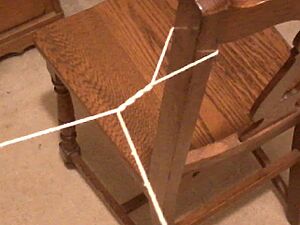Tin can telephone facts for kids
A tin can telephone is a simple device that lets you talk to someone using just two cans or cups and a string. It's like a very old-fashioned phone that doesn't need any electricity! You can make one with two empty tin cans or even paper cups, connected by a string or wire that is pulled tight.
This fun invention works by using sound vibrations. When you speak into one can, your voice makes the bottom of the can vibrate. These vibrations then travel along the string to the other can, where they make the bottom of that can vibrate too. This recreates the sound of your voice, so the person on the other end can hear you!
Contents
How Does a Tin Can Telephone Work?
When you pull the string of your tin can telephone tight, it's ready to send messages! Here's how it works step-by-step:
- Speaking into the Can: When you speak into one can, the sound waves from your voice hit the bottom of the can. This flat bottom acts like a drum skin, vibrating back and forth.
- Vibrations Travel Along the String: These vibrations from the can's bottom make the string vibrate too. The string needs to be pulled very tight, or "taut," for the vibrations to travel well. These vibrations are like tiny waves moving along the string.
- Hearing the Sound: When the vibrations reach the second can, they make its bottom vibrate in the same way. This vibrating can bottom then creates new sound waves in the air, which the person listening can hear. It's like magic, but it's really just science!
The string is super important because it's the "medium" that carries the sound. Without a tight string, the sound can't travel from one can to the other.
Can You Talk Around Corners?
You might wonder if you can use a tin can telephone to talk around a corner. It's a bit tricky, but there are ways to do it!
- Using a Loop: One way is to make a loop in the string and twist it. You can then anchor this twisted loop to another object, like a chair or a pole, to guide the string around the corner.
- Using an Extra Can: Another method involves using an extra can at the corner. You thread the string through the bottom of this extra can. This helps the string avoid touching the object around the corner, which could stop the vibrations from traveling.
History of Acoustic Telephones
People have been experimenting with ways to send voices over distances for a long time. The tin can telephone is an example of an "acoustic" telephone. This means it uses sound waves directly, without needing electricity.
Long before modern electric telephones were invented, people explored how sound could travel through different materials. The tin can telephone shows a basic idea of how sound can be converted into vibrations, sent through a solid object like a string, and then turned back into sound. It's a simple but clever way to communicate!
See also
 In Spanish: Teléfono de lata para niños
In Spanish: Teléfono de lata para niños


